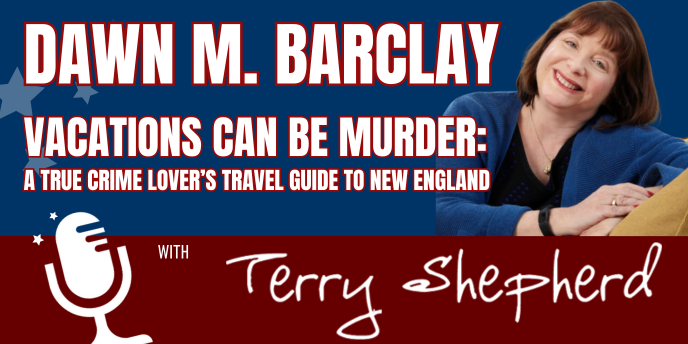Dawn M. Barclay introduces VACATIONS CAN BE MURDER: A True Crime Lover’s Travel Guide to New England—a must-have for anyone obsessed with true crime, haunted history, and dark tourism. From infamous murder scenes to eerie prison tours and haunted hotels, Dawn guides readers to the most macabre (and fascinating) sites New England has to offer.
Hear the Conversation | Get the Book
In a publishing landscape increasingly defined by niches and the readers who obsess over them, Dawn M. Barclay—penning fiction as D.M. Barr—has staked her claim on a curious intersection: true crime tourism. Equal parts travel writer, amateur criminologist, and wry narrator of the bizarre, Barclay’s latest nonfiction offering, Vacations Can Be Murder: A True Crime Lover’s Travel Guide to New England, doesn’t simply chronicle the macabre; it meticulously maps it.
The idea took root, as many do, in motion. While attending Bouchercon—a fan convention for mystery and crime fiction enthusiasts—in Minneapolis, Barclay took a true crime tour through the Twin Cities. Still riding the visibility of her previous nonfiction book about traveling with children on the autism spectrum, she had a revelation: “Are there books that list all the true crime tours in the country?” There weren’t. So she began to write one.
What followed wasn’t just a directory. Barclay’s instinct, as she puts it, is to go “massively comprehensive.” To her, the true crime tourist wants more than a tour—they want context. What crimes were committed in the area? Where did they happen? Where did the perpetrators eat, sleep, or spend their final days? From notorious murder sites and ghost-plagued inns to justice-themed museums and the cemeteries where both victims and villains rest uneasily, Vacations Can Be Murder is a narrative stitched together with forensic precision and dark curiosity.
To gather the raw material, Barclay devoted a month to each state (New England gets its due in the current volume) and another for fact-checking. “This was the first book where I actually had to contact historical societies,” she explains. Some crimes dated back to the 1600s, long before digital archives. Often, the archivists themselves were unaware of the incidents. “They had to research them too.” That element of collaborative detective work lends a subtle layer of meta-intrigue to the book—who else is uncovering forgotten acts of horror alongside her?
And yet, beneath the rigor lies a streak of irreverence. Barclay, who describes herself as “insane this way” when it comes to chasing accuracy, admits to attempting a comedic voice in earlier drafts—before realizing that reference books don’t need voice, just clarity. “It’s not a narrative,” she concedes. “It’s a resource.” That didn’t stop her from writing entries for haunted hotels or once remarking (jokingly) that she’s “never played bondage bingo at a listing” or staged a murder at a diet clinic—cheeky nods to the more outlandish aspects of her fiction.
Barclay is no stranger to fiction’s liberties. Her debut, Expired Listings, about a realtor with a habit of misusing open houses for sinister purposes, was written under a pseudonym to avoid confusion with her real-life sales clients. “I didn’t want them thinking I did those things in their houses,” she laughs. But there are truths embedded in her fiction, too—emotional and psychological ones, if not strictly procedural. Saving Grace, a psychological thriller, pulls from her personal experiences with unsupportive parental figures.
It’s easy to toggle between personas, she insists: D.M. Barr writes fiction; Dawn Barclay writes fact. Her husband, she jokes, is even instructed to refer to her accordingly. It’s a clean bifurcation, born partly of necessity, partly of branding. In truth, Barclay has always walked this line. Raised in a travel agency family, she originally aspired to be a stewardess—more interested in movement than destination. She began writing in earnest after penning a theater review for a friend’s improv group landed her a gig as a nightlife editor. That job led to another at Travel Agent Magazine, and from there, a career unfurled at the curious junction of exploration and storytelling.
Her obsessive attention to detail—as both editor and writer—means she rewrites constantly, lets her computer read drafts aloud, and still agonizes over the inevitable omission. One such slip—a missing statistic from the Connecticut chapter—was remedied via her blog, vacationcanbemurder.com, a digital confession booth and correction board. “I’m a lunatic about getting it right,” she says, not apologetically but as a point of pride.
In the current wave of true crime fascination—where podcasts dissect forensic minutiae and Netflix specials grant killers posthumous celebrity—Barclay sees something deeper. “A lot of the readers are women,” she says, “and they want to know how to get out of situations if they find themselves in them.” There’s comfort in patterns, catharsis in justice, and, perhaps, empowerment in knowing the geography of violence.
Yet, for all its grim content, Vacations Can Be Murder remains a curious celebration—not of crime, but of the human impulse to understand it. It’s the rare book that turns cold case files into vacation planning, where your weekend getaway might include a quick detour past Lizzie Borden’s house, dinner in a haunted tavern, and a museum devoted to penal reform.
Barclay makes no apologies for her eclecticism. She writes poetry and satire. She rescues dogs. She sells real estate. She builds itineraries for death-curious road-trippers. Her world is split in two—fiction and nonfiction—but her passion for storytelling remains indivisible. “I’ve been writing since I was a kid,” she says. “I just didn’t know I’d be writing this.”
What she’s writing, it turns out, is a mirror. A map. A way of understanding the places we fear—by standing exactly where the darkness was.

